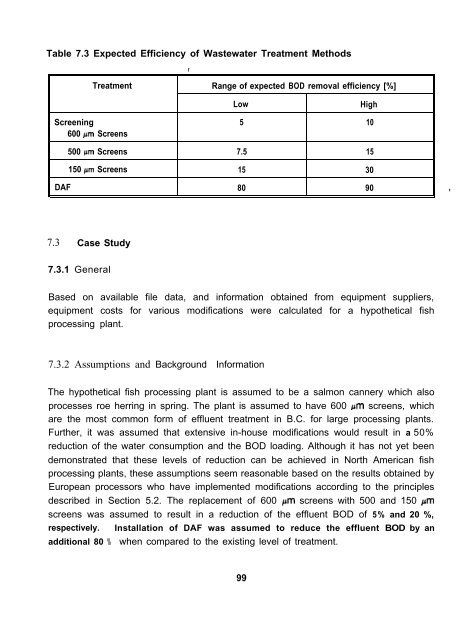9420.pdf
9420.pdf
9420.pdf
You also want an ePaper? Increase the reach of your titles
YUMPU automatically turns print PDFs into web optimized ePapers that Google loves.
Table 7.3 Expected Efficiency of Wastewater Treatment Methods<br />
r<br />
Treatment Range of expected BOD removal efficiency [%]<br />
Low High<br />
Screening 5 10<br />
600 pm Screens<br />
500 pm Screens 7.5 15<br />
150 pm Screens 15 30<br />
DAF 80 90<br />
7.3 Case Study<br />
7.3.1 General<br />
Based on available file data, and information obtained from equipment suppliers,<br />
equipment costs for various modifications were calculated for a hypothetical fish<br />
processing plant.<br />
7.3.2 Assumptions and Background Information<br />
The hypothetical fish processing plant is assumed to be a salmon cannery which also<br />
processes roe herring in spring. The plant is assumed to have 600 ~m screens, which<br />
are the most common form of effluent treatment in B.C. for large processing plants.<br />
Further, it was assumed that extensive in-house modifications would result in a 50%<br />
reduction of the water consumption and the BOD loading. Although it has not yet been<br />
demonstrated that these levels of reduction can be achieved in North American fish<br />
processing plants, these assumptions seem reasonable based on the results obtained by<br />
European processors who have implemented modifications according to the principles<br />
described in Section 5.2. The replacement of 600 pm screens with 500 and 150 ~m<br />
screens was assumed to result in a reduction of the effluent BOD of 5% and 20 %,<br />
respectively. Installation of DAF was assumed to reduce the effluent BOD by an<br />
additional 80 % when compared to the existing level of treatment.<br />
99<br />
*














